Overview:
The article focuses on mastering Power BI themes through the use of JSON, providing a comprehensive guide to creating and applying customized themes that enhance visual consistency and branding. It emphasizes the importance of structured JSON files for defining color palettes and font styles, supported by examples and best practices that help users overcome common challenges in data visualization and reporting.
Introduction
In the world of data visualization, the ability to present information clearly and consistently is paramount. Power BI themes emerge as powerful tools that not only enhance the visual appeal of reports but also ensure alignment with organizational branding standards. As companies strive to make informed decisions based on accurate data insights, understanding how to effectively utilize these themes becomes crucial.
This article delves into the essential aspects of Power BI themes, guiding readers through the creation and application of custom JSON themes, advanced customization techniques, and strategies for overcoming common challenges.
By harnessing the potential of Power BI themes, organizations can significantly improve their reporting processes, foster brand consistency, and ultimately drive operational efficiency.
Understanding Power BI Themes: The Basics
BI styles are crucial groups of formatting options that determine how visuals and dashboards display data. These concepts govern essential aspects like color palettes, font selections, and overall visual styles, allowing users to uphold a uniform and professional look throughout all documents. Currently, there are 2,652 users online, highlighting the active engagement with Power BI and its topics.
By effectively utilizing these concepts, organizations can significantly improve the clarity of their visual representations, ensuring that documents not only communicate information clearly but also conform to corporate branding standards. As Mahmood, an advocate in the community, noted, ‘It would be great if an Admin could confirm this is only in reference to the Admin report,’ emphasizing the importance of clarity in reporting. Comprehending the basics of Power BI themes JSON is essential as it establishes the foundation for developing personalized themes using Power BI themes JSON, which is a lightweight interchange format that is both human-readable and writable.
This customization capability allows directors of operations efficiency to tailor reporting tools to their unique organizational needs, ultimately improving the user experience and decision-making processes. Furthermore, organizations that struggle to extract meaningful insights from their information face a competitive disadvantage. Acknowledging the challenges in utilizing insights from BI dashboards, such as time-consuming report creation, inconsistencies in information, and absence of actionable guidance, is essential.
A case study on ‘Challenges in Self-Service Business Intelligence’ identifies data integration and data security as primary challenges, accounting for 20% and 14% respectively, underscoring critical areas for improvement in self-service BI adoption. Furthermore, incorporating RPA solutions can enhance BI designs, simplifying the reporting process and tackling these challenges efficiently, thus improving operational effectiveness.
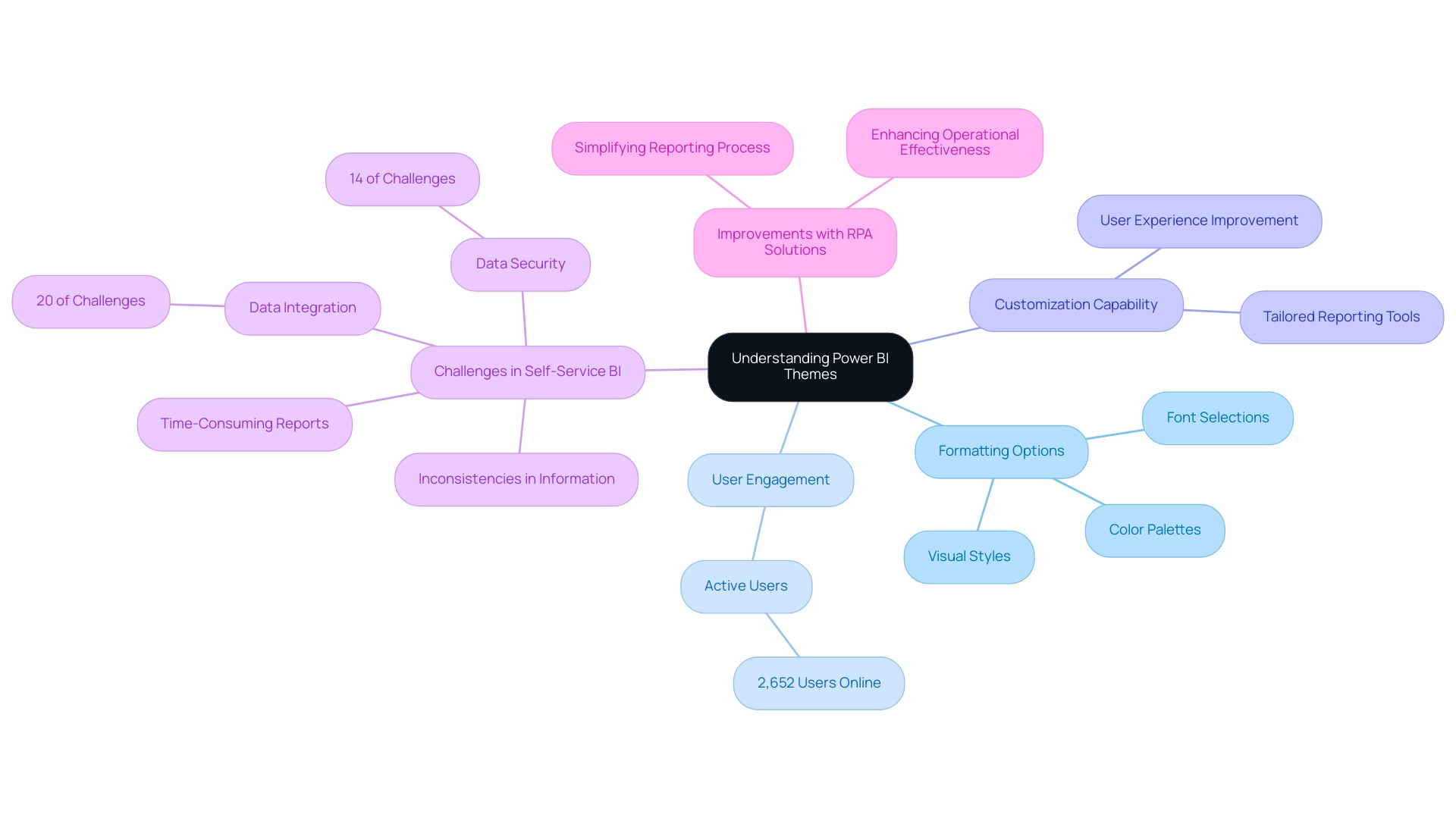
Creating and Applying JSON Themes in Power BI
Creating a power bi themes json for BI begins with defining your preferred color palette and font styles in a structured JSON file. This process helps streamline report creation, ensuring consistency and clarity across your dashboards. An illustrative example is as follows:
json
{
"visualStyles": {
"*": {
"general": {
"wordWrap": true,
"guidelines": {
"show gridlines": true
}
}
}
}
}
As Ruth Pozuelo aptly states, “Hopefully you will find this template as useful as I have and start creating Power BI templates in no time.” By employing organized concepts, you can alleviate the challenges of data inconsistencies, often arising from a lack of governance strategy, and provide clear, actionable insights that guide stakeholders effectively. To further assist you, a video tutorial has been embedded to guide you through the process of using the power bi themes json file for business intelligence designs.
You can access the latest version of the power bi themes json through the provided link. Furthermore, by utilizing code MSCUST, you can improve your operational efficiency with a $150 discount on applicable resources, facilitating your exploration and implementation of customized designs in BI.
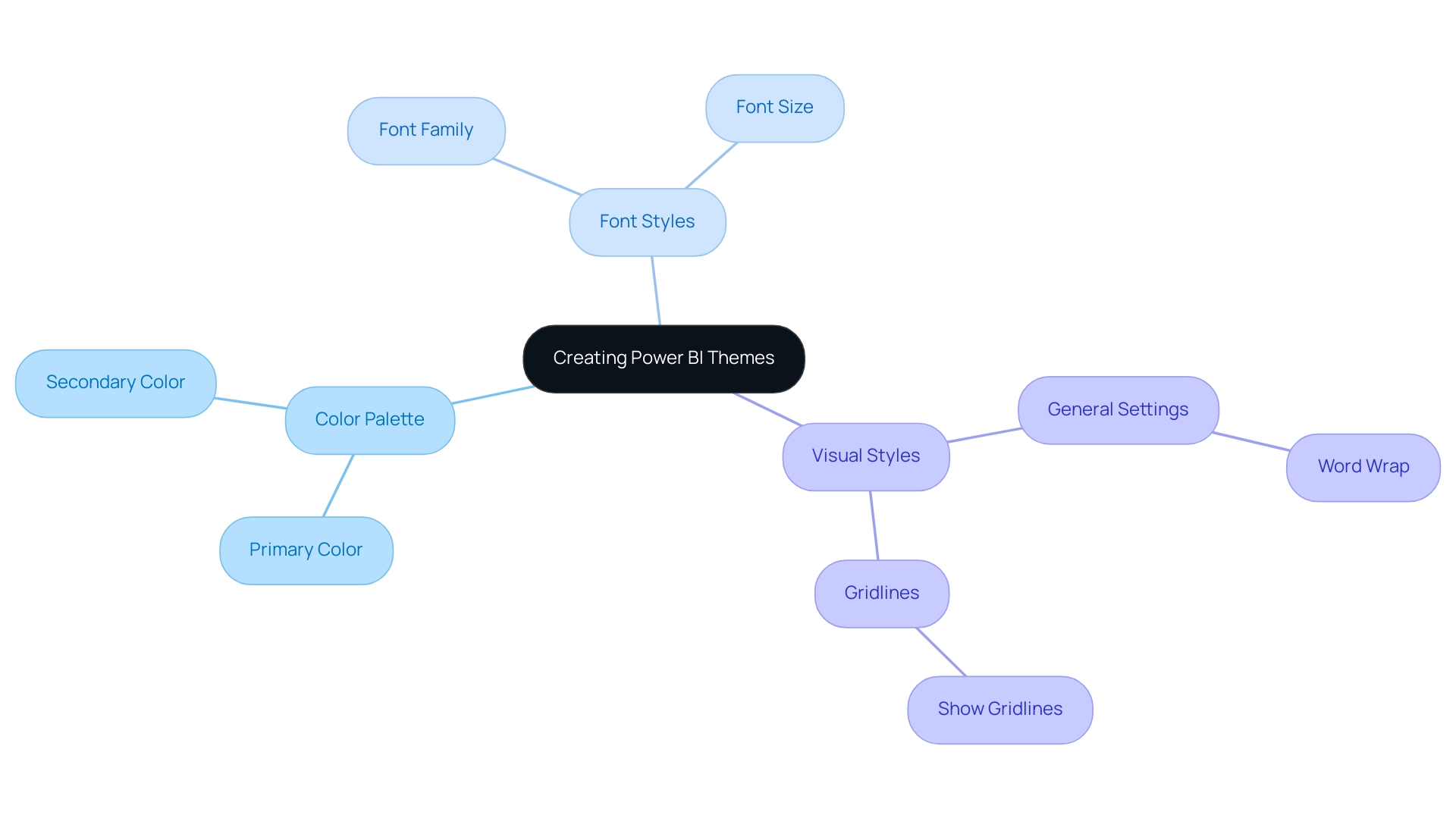
Advanced Customization Techniques for Power BI Themes
To elevate your Power BI themes JSON and overcome common challenges in leveraging insights, delve deeper into the customization of individual visual elements by incorporating custom fonts and colors. For instance, specifying font families directly in your Power BI themes JSON file enhances readability and aesthetics, allowing you to focus on analysis rather than time-consuming document creation. Here’s a sample structure to guide you, which includes properties for first, second, third, and fourth level elements, providing a comprehensive understanding of customization options:
json
{
"visualStyles": {
"*": {
"color": {
"solid": {
"color": "#FFBB78"
}
},
"fontFamily": "Arial"
}
}
}
It’s also important to note that the applied filter card background is set to gray (#E5E9ED), which can be an integral part of your color customization strategy. Moving beyond simple color adjustments, experimenting with gradient colors and shadows can create a more dynamic visual experience. Such techniques not only enhance the overall appeal of your documents but also contribute to a more engaging user experience.
As Paul Waller, a designer, aptly puts it,
It’s very satisfying writing a few lines of code then watching those style changes take effect when updating the report theme.
This satisfaction resonates with many users who embrace customization, as reflected in the case study titled ‘Satisfaction in Coding for Custom Themes.’ Here, overcoming initial coding challenges led to immediate visual enhancements, reinforcing how user preferences for visually appealing representations drive the demand for advanced customization techniques.
However, to fully address the challenges of inconsistencies and the lack of actionable guidance, it’s crucial to implement a robust governance strategy. This guarantees that the data utilized in your documents is accurate and dependable. Additionally, integrating Robotic Process Automation (RPA) and AI solutions can streamline your reporting processes, enhancing operational efficiency and enabling informed decision-making.
By adopting these strategies, you position yourself at the forefront of BI innovation while ensuring your documents provide clear, actionable guidance.
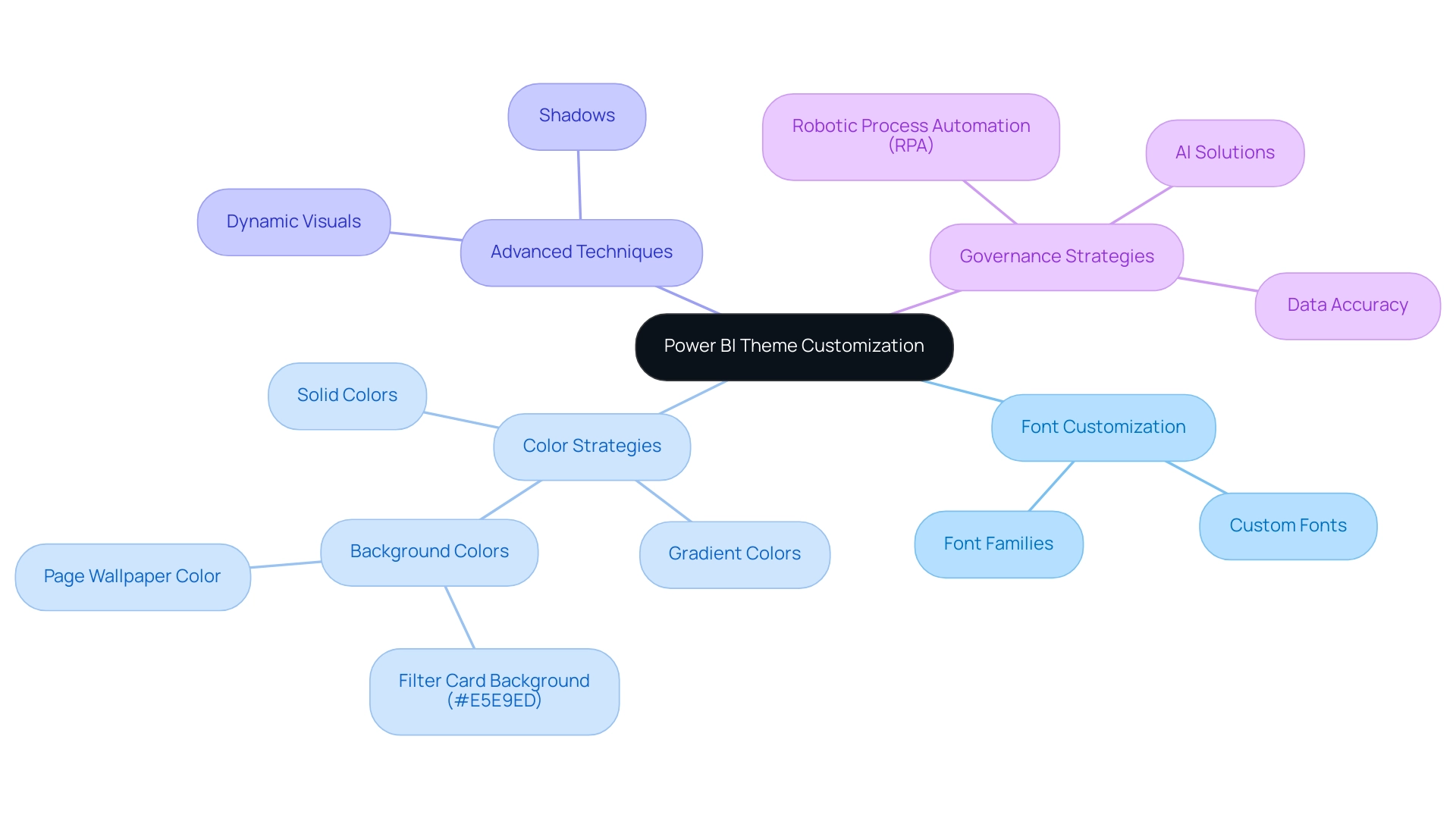
Leveraging JSON Themes for Branding and Consistency
Utilizing power bi themes json in BI can significantly enhance your brand’s visibility within analyses, particularly when combined with strong Business Intelligence practices. It is crucial to ensure that your color palette resonates with your organization’s branding guidelines, while visual elements distinctly reflect the company’s identity. However, obstacles like time-consuming document generation and information inconsistencies often impede effective use of BI dashboards.
By systematically implementing power bi themes json throughout all documents, you not only create a unified experience for users but also enhance operational efficiency and confidence in your information. RPA solutions such as EMMA RPA and Automate can streamline the report creation process, helping to mitigate these challenges. This approach allows stakeholders to swiftly identify and connect with your organization’s materials.
In fact, 81% of consumers consider information transparency vital for trusting a brand, indicating that a consistent visual identity can foster trust and familiarity. Additionally, 64% of consumers make a purchase after viewing a branded social video, underscoring the effectiveness of visual branding in driving consumer behavior. Strong brand loyalty is also evident, as 59% of consumers are willing to wait for their favorite products rather than shop elsewhere, showcasing the powerful impact of cohesive branding strategies.
Furthermore, as Yotpo notes, many shoppers need to buy from a brand five or more times before they consider themselves loyal, reinforcing the importance of consistent branding. Finally, with 72% of people wanting brands to positively contribute to society, a strong brand identity can align not only with consumer preferences but also with broader social values.
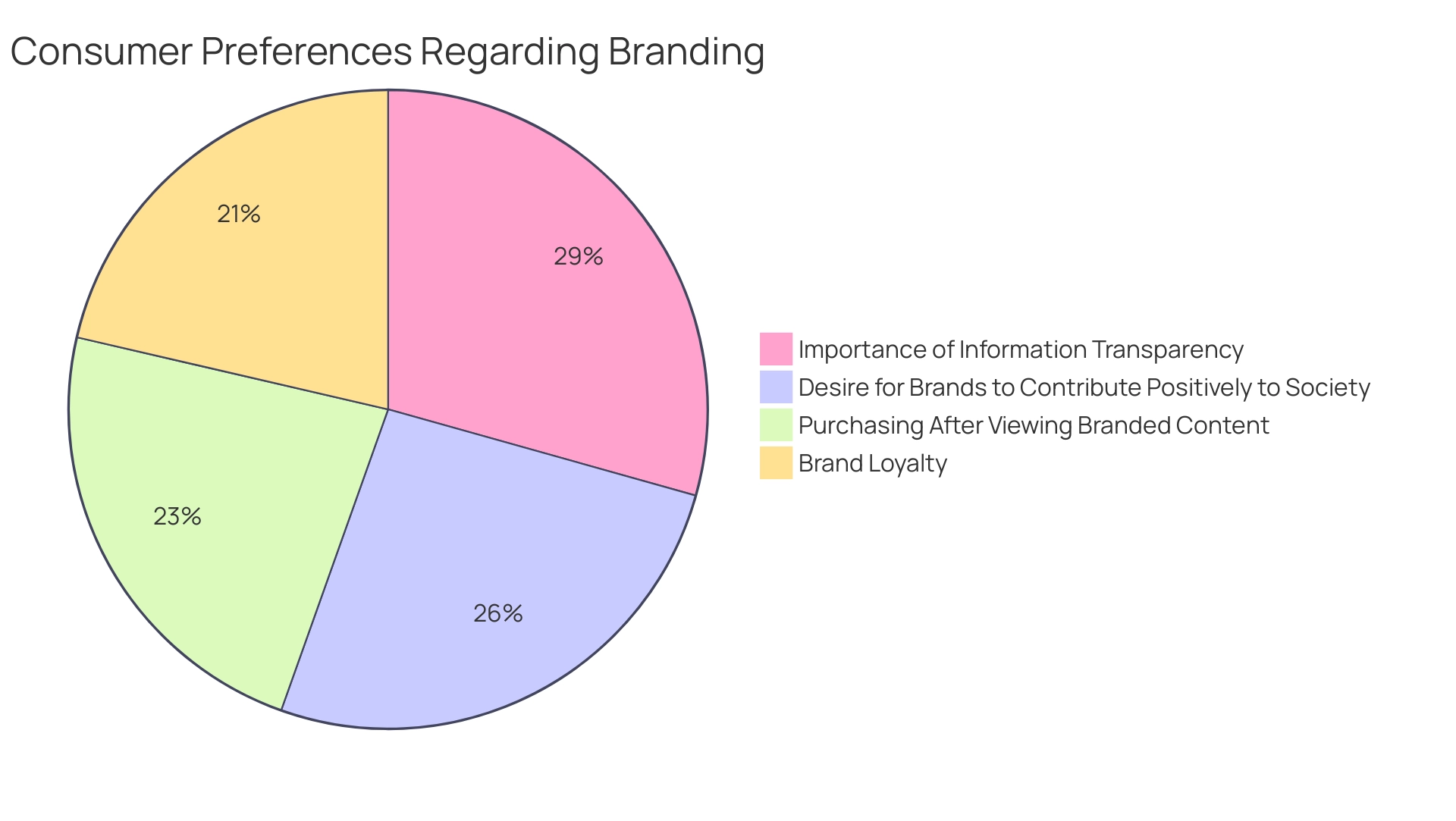
Troubleshooting Common Issues with Power BI JSON Themes
When navigating the complexities of Power BI themes JSON styles, users often encounter common issues such as file format errors and inconsistencies in the application of Power BI themes JSON, which can hinder effective data analysis and reporting. Many users express frustration over the default styling of BI dashboards, complicating the customization process and diverting focus from leveraging actionable insights. To enhance efficiency, it is crucial to ensure your Power BI themes JSON file is correctly formatted; utilize an online JSON validator to catch any potential syntax errors prior to import.
If your design isn’t working as anticipated, an important first step is to verify that your BI version is up to date, as earlier versions may not support newer features. Additionally, verifying that the color codes and font names specified in your Power BI themes JSON file align with those available in Power BI can save time and reduce inconsistencies. As Zoe Zhi from Community Support observed, ‘I test this in my environment (July 2019 desktop), and I get below result when I import JSON by clicking switch appearance -> import appearance.’
This highlights the significance of ensuring compatibility when applying custom designs. By proactively tackling these typical obstacles, including the difficulties of lengthy documentation generation and data discrepancies, you can optimize your application process and improve your team’s capacity to extract valuable insights from BI. Furthermore, integrating Robotic Process Automation (RPA) can significantly reduce manual tasks associated with report generation, allowing your team to focus on analysis rather than creation.
The case study titled ‘Amending Your Visuals‘ discusses limitations in the Power BI customize theme framework and offers workarounds using Power BI themes JSON, providing valuable insights into how users can override default formatting options to maintain visual consistency when changing themes. This approach not only empowers your operations but also fosters a culture of informed decision-making, ensuring that data governance strategies are in place to guide stakeholders on actionable next steps.
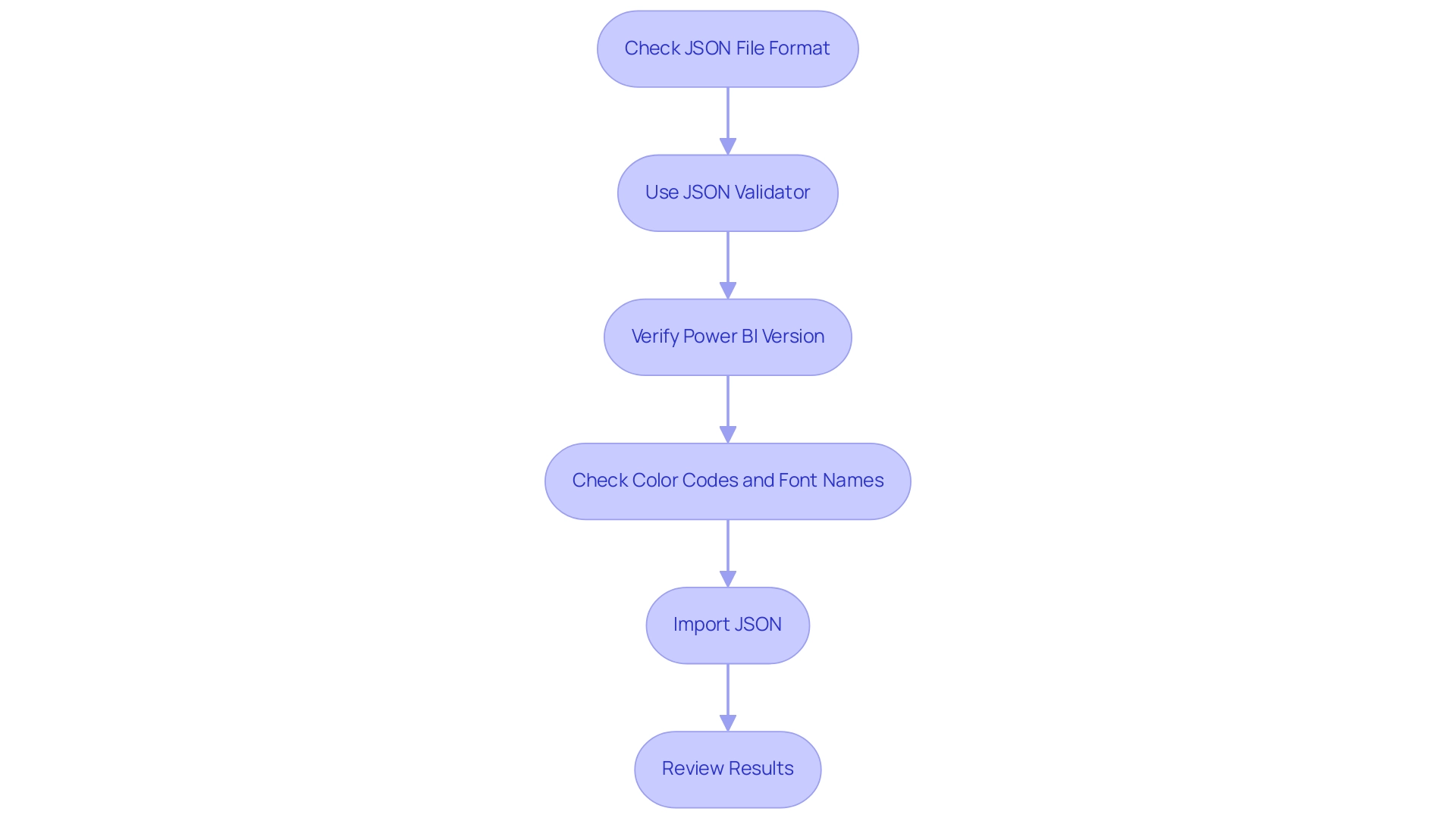
Conclusion
Power BI themes are more than just aesthetic enhancements; they are essential tools that drive clarity, brand consistency, and operational efficiency in data reporting. By understanding the fundamentals of Power BI themes, creating customized JSON themes, and employing advanced customization techniques, organizations can significantly improve their data visualization processes. These practices not only streamline report creation but also align visual presentations with corporate branding standards, fostering trust and engagement among stakeholders.
Moreover, overcoming common challenges such as data inconsistencies and time-consuming report generation is crucial to maximizing the benefits of Power BI. Implementing a robust governance strategy, integrating RPA solutions, and ensuring proper formatting of JSON files are key steps in this journey. By addressing these issues proactively, organizations can enhance their reporting capabilities and derive actionable insights that inform decision-making.
Ultimately, leveraging Power BI themes is a strategic advantage that empowers organizations to present data in a visually appealing and coherent manner. As businesses continue to prioritize data-driven strategies, embracing these tools will not only improve reporting efficiency but also strengthen the connection between data insights and organizational goals. Now is the time to harness the full potential of Power BI themes to elevate your reporting processes and drive operational success.

